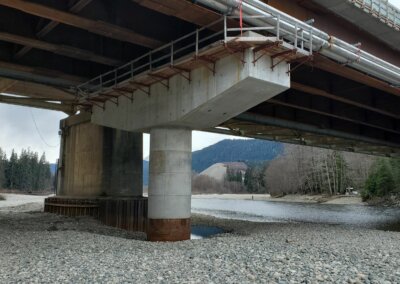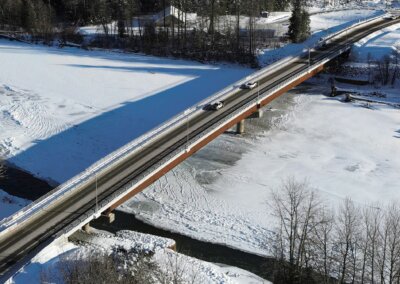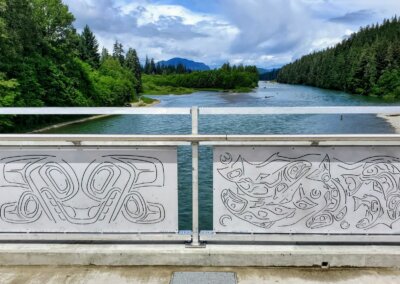About the Project
The Haisla Bridge is a critical river crossing in BC’s North Coast, linking the community of Kitimat to its industrial partners, including LNG Canada and Rio Tinto. Built in 1954, the bridge was approaching the end of its service life. With funding from Pacific Economic Development Canada and in partnership with the Haisla Nation, the District of Kitimat embarked on a four-year project to rebuild this essential infrastructure to meet today’s demands for vehicle, cyclist and pedestrian traffic.
The $60M project was delivered using a design-build (DB) process. Construction was led by the Haisla-Ledcor Limited Partnership, and design led by Associated Engineering.
The centrepiece of the project is the 235m long girder bridge over the Kitimat River. Additional works included 1km of realigned road approaches, drainage, erosion and scour protection, utilities and the complex removal of the old bridge.
The Kitimat River is home to oolichan, trout, and all five species of North American salmon. This diverse fish population means that there is no “lowest risk to fish” window year-round. The Owner’s team determined the only solution was to work outside of the river. Construction was limited to dry portions of the river. However, Kitimat River is famously “flashy” – dry portions of the river could be inundated within hours. These constraints challenged the DB team to develop innovations for design and construction of the new crossing and removal of the old bridge.
The project advanced reconciliation on many levels. A collaborative approach resulted in positive relationships between the Haisla Nation, the Federal and Municipal governments, and private construction/design firms. Haisla Nation was a partner in the inter-governmental oversight committee during project development and Ledcor’s construction partner. Meaningful engagement with the Haisla community was further achieved through public events, and installation of permanent art panels and a new totem pole dedication
Approach
From project outset, all team members embraced a collaborative approach and sought to engage the Haisla Nation.
Understanding the schedule constraints, the Owner’s team submitted environmental applications early in the Project Definition phase, developing a robust reference concept design that locked in key design parameters and construction methods.
The Design-Build team recognized the pre-established permitting obligations and sought innovations to reduce the bridge footprint and construction impacts. The “hammerhead” profile for the piers ultimately reduced the bridge’s in-stream footprint by 85%, compared to the existing, thereby returning crucial river habitat. Steel girders were tapered to allow a lower road profile, reducing walls and embankments. Full-width precast deck panels were designed to eliminate all soffit formwork and the risks associated with cast-in-place concrete over the watercourse.
Key construction strategies critical to the project’s success were: 1- New Bridge: the 190m incremental “push” launch of four parallel girders from land onto piers. 2- Old Bridge: the lateral slide of the old lead-paint-coated truss spans onto the new bridge, followed by the heavy-lift transport of the intact, old spans to a secure disposal site. These two complex work activities ensured zero impact to the river and reduced project risk by utilizing the dry portions of the riverbed for only light equipment that could be demobilized within hours if river levels changed.
Results
The new Haisla Bridge was delivered on budget in 33 months, despite extensive permitting requirements, historic inflation, an atmospheric river event, and a global pandemic. Through a collaborative approach and innovative design and construction, work was completed outside the environmentally sensitive wetted river zone and reinstated 55m2 of critical spawning habitat. The project provides a safe and reliable link to Kitimat’s industrial lands and advances reconciliation with the Haisla Nation.
Service(s) Provided
• Project Delivery Strategy
• Partnership Facilitation
• Owner’s oversight
• Structural Design
• Roadway Design
• Geotechnical Design
• Hydrotechnical Design
• Erosion Control
• Drainage Design
• Utility Design
• Environmental Permitting, Mitigation and Monitoring
• Traffic Management
• Permanent Works Construction including Bridge, Roadworks and Utilities
• Temporary Works Design and Construction including Girder Launch and Demolition
Project Team (Consultants)
Thurber Engineering
Hatfield Consultants
BASIS Engineering
Project Team (Contractors )
Ledcor-Haisla Limited Partnership
All-Span Engineering & Construction Ltd.
Supreme Structural Transport Ltd.
Western HI
Go back to projects in
View other projects from
Stay in touch with us
Subscribe to our mailing list!
Organization
Connect






